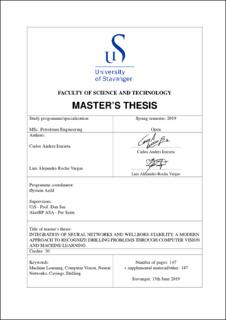| dc.contributor.advisor | Sui, Dan | |
| dc.contributor.author | Izurieta, Carlos Andres | |
| dc.contributor.author | Rocha Vargas, Luis Alejandro | |
| dc.date.accessioned | 2021-04-19T13:00:19Z | |
| dc.date.available | 2021-04-19T13:00:19Z | |
| dc.date.issued | 2019-06-15 | |
| dc.identifier.uri | https://hdl.handle.net/11250/2738399 | |
| dc.description | Master's thesis in Petroleum engineering | en_US |
| dc.description.abstract | Cavings are an endless and valuable source of information when drilling operations is being performed. Multiple parameters can contribute to produce cavings which indicate that failure has occurred or is about to occur downhole. This project is an integrated study of Machine Learning, Computer Vision, Geology and Photography so that the recognition of cavings in the shaker is possible and how to link the cavings morphology with causal mechanisms related to wellbore instability problems. The aim of this study is to develop a model which is able to extract caving features such as Shape, Edge Definition, Colour and Size.
The methodology consists in developing a structured image database of cavings from the Norwegian Continental Shelf which it is used to extract features. Different algorithms are used to investigate on the best approach to correctly detect the shape of the caving, from supervised learning, K-Nearest Neighbors proved to be the one with the best results, up to 67% of accuracy but not good enough for an object detection project, therefore unsupervised learning was implemented and different architectures of neural networks used. From the simplest with one hidden layer to state-of-the-art architectures as InceptionV3 and YoloV3 were used. The latest proved to be a robust solution to correctly detect the caving with up to 98% of accuracy.
The edge definition feature involved an analysis using computer vision and a mathematical approach to calculate circularity of objects, and this is performed using top view images of the samples where area and perimeter values are relevant. Also, computer vision and k-means method is used to extract the most dominant colours from a caving treating every single image as MxN pixels which are the data points to be clustered. Furthermore, to compute size feature, computer vision and a color scale as a reference object are used to identify caving centroid and calculate width and height of cavings.
A dataset of 1,064 samples of cavings was built from scratch, it was used to successfully train and validate different algorithms and architectures of Neural Networks. Up to 7 different shapes of caving can be recognized with an accuracy of 98% if the proper conditions of the picture are met. Regarding edge definition, the used approach allows us to have circularity values which can be associated with how smooth the edges of the cavings are. This is suitable for non elongated cavings.This model is able to obtain 3 dominant colours from caving, RGB codes and their percentages. Also, measuring the caving size was accomplished with high level of accuracy.
N.B.: This report includes relevant parts of the code used to pre-process the data, manipulate the data, train and validate the different algorithms and neural networks. The complete code has been delivered to the exam office at the University of Stavanger. | en_US |
| dc.description.sponsorship | University of Stavanger | en_US |
| dc.language.iso | eng | en_US |
| dc.publisher | University of Stavanger | en_US |
| dc.relation.ispartofseries | Masteroppgave/UIS-TN-IEP/2019; | |
| dc.rights | Attribution-NonCommercial-NoDerivatives 4.0 Internasjonal | * |
| dc.rights | Attribution-NonCommercial-NoDerivatives 4.0 Internasjonal | * |
| dc.rights.uri | http://creativecommons.org/licenses/by-nc-nd/4.0/deed.no | * |
| dc.subject | petroleumsteknologi | en_US |
| dc.subject | petroleum engineering | en_US |
| dc.subject | boreteknologi | en_US |
| dc.subject | machine learning | en_US |
| dc.subject | computer vision | en_US |
| dc.subject | neural networks | en_US |
| dc.subject | drilling | en_US |
| dc.subject | maskinlæring | en_US |
| dc.title | Integration of Neural Networks and Wellbore Stability, a Modern Approach to Recognize Drilling Problems Through Computer Vision and Machine Learning | en_US |
| dc.type | Master thesis | en_US |
| dc.subject.nsi | VDP::Technology: 500::Rock and petroleum disciplines: 510::Petroleum engineering: 512 | en_US |

